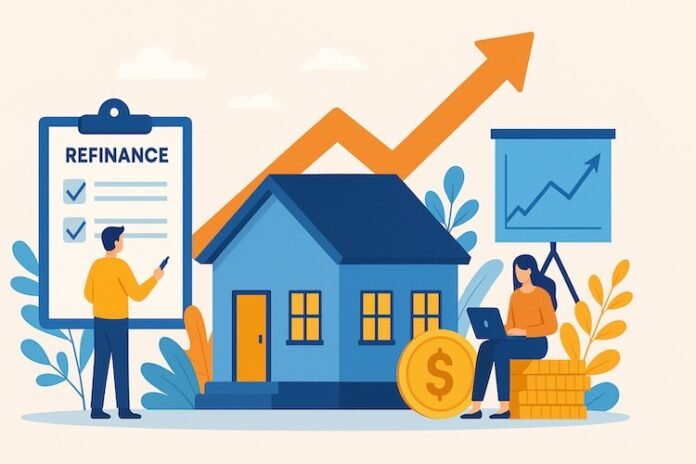Save more, stress less: Smart refinancing strategies every homeowner should know.
Homeownership is a long-term financial journey, and along the way, your mortgage may no longer serve your current goals. Whether interest rates have dropped, your financial situation has improved, or you’re simply looking to reduce monthly payments, refinancing your home loan can be a powerful tool—when done right.
But refinancing isn’t just about swapping one loan for another. To truly benefit, you need a clear strategy, market awareness, and a good understanding of your financial profile. Here’s a step-by-step guide to help you refinance your home loan smartly in 2025.
1. Understand What Home Loan Refinancing Means
Refinancing a home loan means replacing your existing mortgage with a new one—ideally with better terms. Your new loan pays off the old one, and you begin repayment on the new agreement.
Why refinance? Common reasons include:
- Lower interest rates
- Reducing monthly payments
- Shortening or extending the loan term
- Switching from a floating to fixed rate (or vice versa)
- Accessing home equity for renovations or other needs
Refinancing can unlock significant savings over time, but only when approached strategically.
2. Evaluate the Right Time to Refinance
The best time to refinance is when market rates are lower than your existing loan or when your personal finances have improved.
In 2025, several homeowners are exploring refinancing options due to:
- Softer lending rates compared to the last 2–3 years
- Property value appreciation (increasing refinancing eligibility)
- Competitive loan packages from both local and international banks
Tip: If the new rate is at least 0.75% to 1% lower than your current rate, it may be worth refinancing—provided the cost of switching is manageable.
3. Calculate Your Break-Even Point
Refinancing isn’t free. There are legal fees, valuation fees, administrative charges, and potential penalties for early repayment (especially during a lock-in period). So before making the leap, calculate your break-even point—the time it takes for your monthly savings to cover the cost of refinancing.
Example:
If refinancing saves you $300/month and costs $5,000 upfront, your break-even point is ~17 months. If you plan to stay in the property beyond that, refinancing is likely worth it.
Use online refinancing calculators or consult with a mortgage advisor to get accurate figures.
4. Compare Offers from Multiple Lenders
Don’t just go back to your current lender. Comparing loan packages across multiple banks is essential to getting the best deal.
Look for:
- Lower interest rates
- Flexible repayment options
- Shorter lock-in periods
- Reduced fees and charges
- Perks like legal subsidies or valuation waivers
This is also the point to consider refinancing to lowest home loan rates from banks like DBS, which frequently offer competitive rates to attract refinancers. However, every bank has different criteria, so what’s ideal for one borrower may not be for another.
Working with a licensed mortgage broker or advisor can help you navigate these offers and negotiate better terms.
5. Assess Your Current Financial Profile
Your eligibility for refinancing depends on factors like:
- Income and employment status
- Credit score
- Outstanding debts (credit cards, car loans)
- Property value
- Loan-to-Value (LTV) ratio
- Total Debt Servicing Ratio (TDSR)
Improved income or a rise in property value enhances your refinancing profile. Conversely, taking on new debt or irregular income may hurt your chances.
Before applying, take steps to clean up your credit, pay down debt, and stabilize income—especially if you’re self-employed or an expat.
Also read: Mortgages vs Home Equity Loans
6. Consider Your Long-Term Goals
Refinancing should align with your overall financial plan.
- Want to retire early? Refinance to a shorter term to pay off your loan faster.
- Need more cash flow? Opt for lower monthly payments with a longer term.
- Worried about rate hikes? Switch to a fixed-rate mortgage for stability.
- Thinking of selling soon? Avoid long lock-in periods and heavy penalties.
Mortgage flexibility can make or break your long-term savings. Be sure your new loan terms match your lifestyle goals.
7. Don’t Overlook the Fine Print
Before signing anything, review:
- Lock-in period and break fees
- Prepayment penalties
- Repricing options and schedules
- Legal subsidy clauses (sometimes banks claw these back if you refinance again too soon)
Always ask for a Loan Fact Sheet from your lender that summarizes key terms. If anything is unclear, seek clarification or legal counsel.
Also read: Need a Personal Finance Makeover? Try These Tactics
Final Thoughts
Refinancing your home loan in 2025 can be one of the smartest financial moves you make—if you do it for the right reasons, at the right time, and with the right support.
Evaluate your goals, compare offers, and work with professionals to ensure you’re not just chasing a lower rate, but building a more secure and flexible financial future.
Want to explore your refinancing options today?
Start with a comparison of lowest home loan rates from banks like DBS and others—tailored to your profile and goals. A trusted mortgage advisor can help you find the best deal with minimal hassle and maximum savings.

